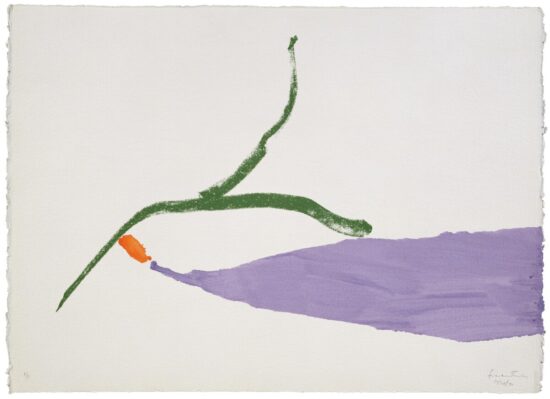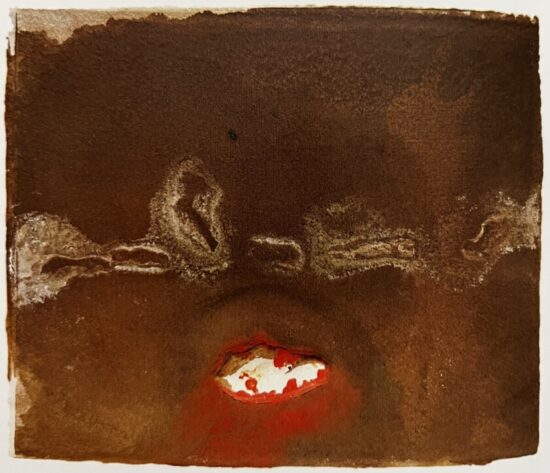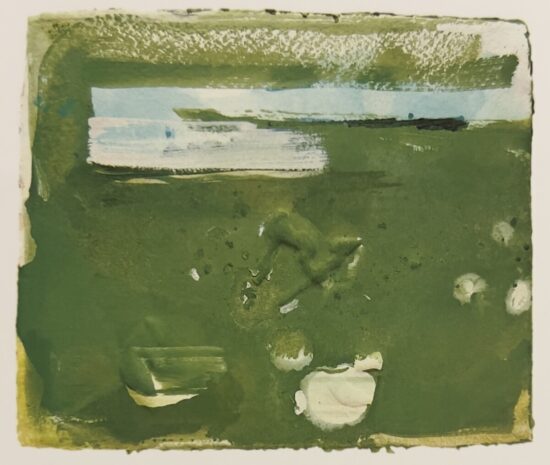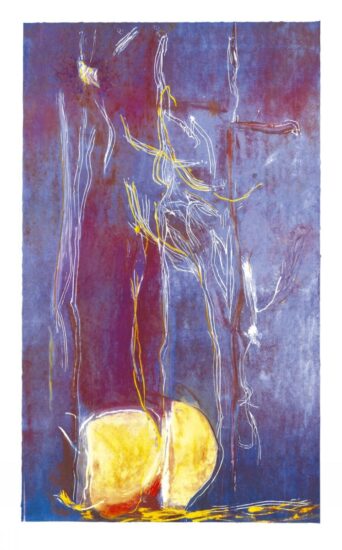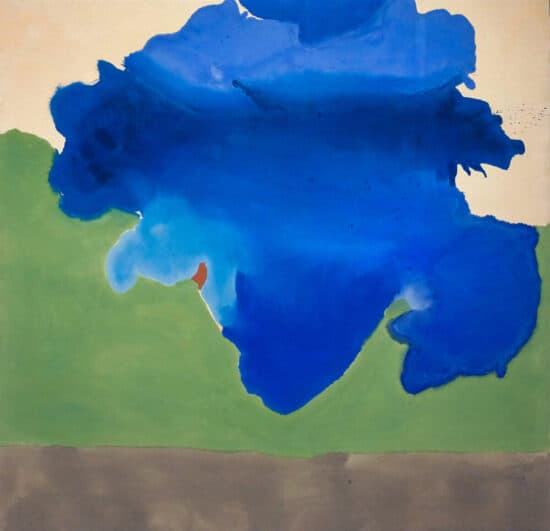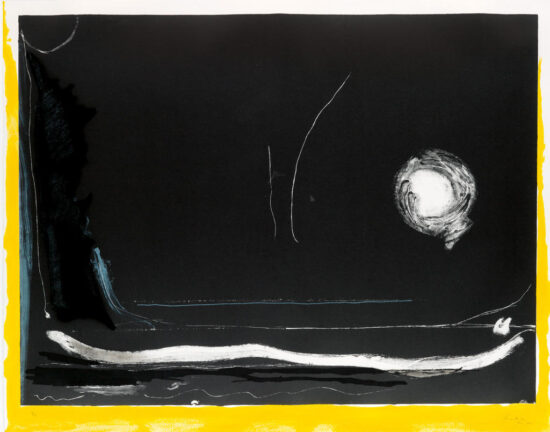What is the artistic style of Helen Frankenthaler's paintings?
Helen Frankenthaler's paintings are known for their use of the unique "soak-stain" technique, pioneered by Frankenthaler in the 1950s. The technique involves applying thinned paint onto raw canvas, allowing it to soak in and blend with the fabric. The result is vibrant, ethereal compositions that emphasize color and spontaneity over precise control.
How did Helen Frankenthaler contribute to the abstract expressionist movement?
Helen Frankenthaler was a key figure in the abstract expressionist movement for her invention of the soak-stain technique. The luminous, flowing compositions that this technique allowed her to create has significant influence on artists like Morris Louis and Kenneth Noland.
Helen Frankenthaler’s work is a testament to her innovative approach to abstract expressionism. Her paintings exude a sense of fluidity and spontaneity, with vibrant colors blending seamlessly on the canvas. Frankenthaler's work often reflects her deep connection to nature and the elements, capturing the essence of landscapes and emotions in a unique way. Through her use of staining techniques and bold brushstrokes, she creates dynamic compositions that draw viewers into a world of color and movement.
Frankenthaler: Exploring Her Timeless Paintings
Key Highlights
- Helen Frankenthaler was an influential American abstract expressionist painter known for her contributions to the postwar American painting movement.
- Her work spanned several decades and went through various stylistic shifts, making her a significant figure in the art world.
- She was associated with the Color Field movement and her large-scale paintings were known for their fluid shapes and lyrical gestures.
- Frankenthaler's work was highly influential and she was recognized with numerous retrospective exhibitions and awards.
- Her techniques and use of color continue to inspire artists around the world today.
Introduction
Helen Frankenthaler, an American abstract expressionist painter, left a lasting impact on the art world with her innovative techniques and unique style. Born on December 12, 1928, in New York City, Frankenthaler began exhibiting her large-scale abstract expressionist paintings in the early 1950s. She was an important figure in the Color Field movement, which emphasized the use of color and shape, rather than brushstrokes, to create emotional and expressive works of art. Frankenthaler's contributions to the art world are especially significant as she was required to forge her own path in the mid-20th century, male-dominated art world, where talented women artists were often overlooked. She received her earliest art instruction from Rufino Tamayo at the Dalton School and continued her education at Bennington College, where she studied with Paul Feeley, Hans Hofmann, and David Smith.
Frankenthaler's paintings are characterized by their fluid shapes, lyrical gestures, and emphasis on spontaneity. She had a remarkable ability to capture the essence of nature and translate it onto canvas. Her work was influenced by artists such as Hans Hofmann and Jackson Pollock, as well as art critic Clement Greenberg.
Throughout her career, Frankenthaler received widespread recognition and was the subject of numerous retrospective exhibitions. Her work continues to be celebrated for its innovation and impact on the art world. Frankenthaler passed away on December 27, 2011, but her legacy lives on through her timeless paintings.
The Legacy of Helen Frankenthaler
Helen Frankenthaler's work continues to leave a lasting legacy in the art world. Her work is currently represented by the Artists Rights Society, which ensures that her artistic vision is protected and promoted. Additionally, the Helen Frankenthaler Foundation, a not-for-profit corporation that Frankenthaler created in 1984 and that became active in 2013, supports the study and appreciation of her work. These organizations contribute to the preservation and promotion of Frankenthaler's art, allowing future generations to experience and be inspired by her unique contributions to abstract expressionism.
The Mark of Abstract Expressionism
Abstract Expressionism, a prominent art movement that emerged in New York in the post-war era, had a profound influence on Helen Frankenthaler's work. Artists such as Jackson Pollock and Hans Hofmann were at the forefront of this movement, pushing the boundaries of traditional painting techniques and exploring new ways to express emotions and ideas. Frankenthaler's work is often associated with the New York School, a group of artists who were part of the Abstract Expressionist movement in the city, based on her pivotal visit to Jackson Pollock's studio in East Hampton.
Frankenthaler's paintings were deeply rooted in the principles of Abstract Expressionism, influenced by her father, Alfred Frankenthaler, a respected New York State Supreme Court judge and her nephew, artist and photographer Clifford Ross. She embraced the spontaneity and expressive potential of the medium, allowing her to create works that captured the essence of her emotions and experiences. Through her use of color, texture, and composition, Frankenthaler left a mark on the art world, contributing to the evolution and development of abstract expressionism as a whole and paving the way for future artists from Manhattan's Upper East Side to pursue professional careers in the field.
Innovations in Color Field Painting
Color Field painting, a subset of abstract expressionism, focused on the use of large areas of color to evoke emotional responses from viewers. Helen Frankenthaler's work played a significant role in the development of this movement.
Frankenthaler's use of color and her exploration of the relationship between color and emotion resonated with art critic Clement Greenberg, who included her work in the 1964 Post-Painterly Abstraction exhibition. Her contributions to color field painting continue to inspire artists today, as she pushed the boundaries of what could be achieved with color and composition.
The Soak-Stain Technique
Frankenthaler's unique technique, known as the soak-stain technique, was a defining aspect of her artistic approach. This technique involved pouring thinned paint onto unprimed canvas, allowing the paint to soak into the fabric and create layers of color. The result was a sense of depth and movement, with vibrant and translucent layers that captured the essence of her emotions and experiences. This technique became synonymous with Frankenthaler's work and contributed to the development of color field painting as a whole.
One of her most influential works, "Mountains and Sea," created in 1952, was among the earliest of her works to gain recognition for using soak-stain. Although the soak-stain technique creates an image that is abstract in nature, it also suggests the forms and colors of a natural landscape. Rather than bein literal or realistic, the references to landscape that are present in this piece are abstracted impressions that capture the essence of the natural landscape through vibrant colors and loose forms.
The soak-stain technique allowed Frankenthaler to explore the relationship between color and emotion in a new and innovative way. Her paintings became a visual representation of her inner world, inviting viewers to experience the same emotions through the vibrant and translucent layers of color.
Frankenthaler's Impact on Modern Art
Helen Frankenthaler's impact on modern art cannot be understated. Her innovative techniques and unique style pushed the boundaries of traditional painting and paved the way for future generations of artists.
Her contributions to abstract expressionism, particularly with the soak-stain technique and her exploration of color and emotion, continue to inspire artists today. Frankenthaler's ability to capture the essence of nature and translate it onto canvas created a new language in modern art.
Her work has been exhibited worldwide and continues to be celebrated for its innovation and impact. Frankenthaler's paintings, such as "Star Gazing" (1989), remind us of the power of art to evoke emotions and connect with viewers on a deep level. Her legacy lives on through her timeless paintings and the influence she has had on modern art, as seen in the inclusion of her painting, Star Gazing, alongside works by other influential artists such as Anselm Kiefer, in the exhibition "Starry Night and Beyond: Van Gogh's Impact on Modern Art."
Two Key Works
These key works, along with many others, are significant in Frankenthaler's body of work and highlight her contributions to the art world. They continue to captivate viewers and serve as a testament to her artistic vision.
"Mountains and Sea": A Turning Point
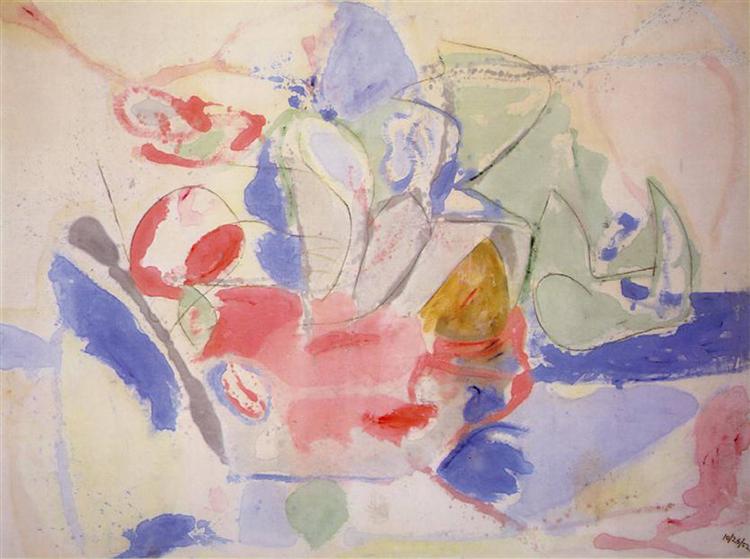
This influential painting, created in 1952, is widely regarded as a turning point in Frankenthaler's career. It marked the debut of her soak-stain technique, which would become synonymous with her work and have a lasting influence on the art world, consequently solidifying her reputation as an innovative artist.
"Mountains and Sea" captures the essence of nature through its vibrant and translucent layers of color. The painting's abstract forms suggest a landscape, evoking a sense of depth and movement. It was an innovative departure from traditional painting techniques that emphasized brushstrokes as a way to create movement and emotion, and it helped Frankenthaler emerge as an important figure in the art world.
Today, "Mountains and Sea" is considered a masterpiece of abstract expressionism and is housed in the collection of the Museum of Modern Art in New York City. It continues to inspire artists and captivate viewers with its timeless beauty.
"The Bay": Exploring Color and Space
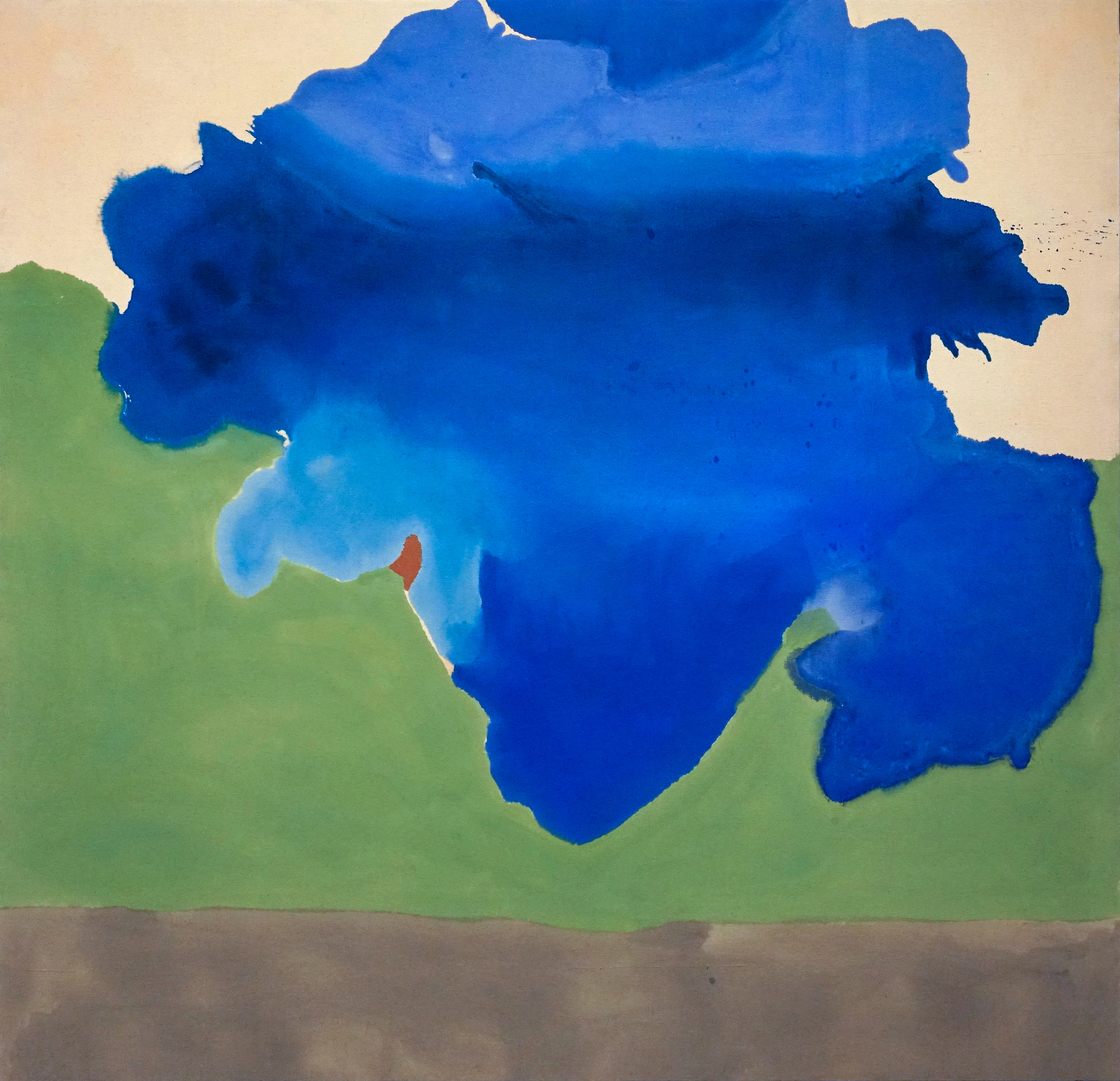
"The Bay," created in 1963, is a striking example of her exploration of color and space in painting. This work exemplifies Frankenthaler's ability to create a sense of depth and movement with minimalistic compositions, showcasing her mastery of composition and color.
Using a very limited color palette of blues, green, and brown, Frankenthaler captures viewers' attention with a strikingly deep blue that takes up most of the canvas. The imposing swath of blue seems to seep down the canvas as it's range of blue tones run into each other, indicating the artist's method — pouring wet paint on the unprimed canvas rather than brushing it on. The title of the piece suggests that the blue shape is perhaps meant to remind viewers of a body of water. But above all, The Bay is an excellent example of Frankenthaler's ability to use soak-stain and strong colors to create compelling and dynamic compositions.
"The Bay" exemplifies Frankenthaler's ability to balance abstraction and representation, creating a harmonious interplay of colors and shapes space. It is a testament to her mastery of composition and her innovative approach to painting.
Exhibitions Around the World
Helen Frankenthaler's work has been showcased in exhibitions around the world, cementing her status as a renowned artist. Her paintings have been displayed in prestigious institutions such as the Museum of Modern Art in New York and have been featured in international exhibitions.
These exhibitions provide an opportunity for viewers to experience the depth and beauty of Frankenthaler's artwork firsthand. They celebrate her contributions to the art world and allow audiences to connect with her unique artistic vision.
Retrospective Glances
Retrospective exhibitions of Helen Frankenthaler's work provide a comprehensive look at her artistic journey and highlight her significant contributions to the art world.
These exhibitions, held in renowned museums such as the Museum of Modern Art, showcase the evolution of her style and the impact of her innovative techniques. They offer viewers a chance to explore the depth and breadth of her body of work, from her early abstract-expressionist paintings to her later color-field masterpieces. In 1951, she was also included in the landmark Ninth St. Art Exhibition of Paintings and Sculpture in New York, and her first solo exhibition was presented at New York's Tibor de Nagy Gallery, where she met influential artists such as Willem de Kooning. These retrospectives offer a unique glimpse into the career of this influential artist.
Through retrospective exhibitions, audiences can gain a deeper understanding of Frankenthaler's artistic process and the themes that influenced her work. They celebrate her legacy and ensure that her contributions to art are remembered and appreciated.
Current and Upcoming Shows
Current and upcoming exhibitions of Helen Frankenthaler's work provide an opportunity for audiences to engage with her art in a contemporary context. These shows, held in galleries and art institutions worldwide, showcase the enduring relevance of her paintings.
Through these exhibitions, viewers can experience the timeless beauty and emotional depth of Frankenthaler's work. They provide an immersive and thought-provoking experience, allowing audiences to connect with her artistic vision and explore the power of color, composition, and emotion.
Upcoming exhibitions offer a glimpse into the future of Frankenthaler's legacy, as her work continues to inspire and captivate audiences around the world. They ensure that her contributions to the art world are celebrated and continue to be recognized.
Influences and Inspirations
Helen Frankenthaler drew inspiration from various sources, including music, nature, and landscapes. These influences shaped her artistic vision and contributed to the development of her unique style.
Music, with its rhythm and emotion, served as a guiding force in Frankenthaler's work. She often listened to music while painting, allowing the melodies to inspire her brushstrokes and color choices.
Nature and landscapes were also significant influences on Frankenthaler. She captured the essence of natural forms and translated them onto canvas, creating works that evoked the beauty and tranquility of the natural world.
These influences and inspirations are evident in Frankenthaler's timeless paintings, which continue to resonate with viewers and serve as a testament to her artistic vision.
The Role of Music in Frankenthaler's Process
Music played a significant role in Helen Frankenthaler's creative process and the development of her artistic style. She often listened to music while painting, using it as a source of inspiration and a way to connect with her emotions. Frankenthaler believed that music had the power to evoke certain moods and feelings, which she translated onto canvas through her use of color, shape, and gesture. The rhythm and harmony of music influenced the flow and movement of her brushstrokes, resulting in dynamic and expressive compositions. By incorporating the principles of music into her painting process, Frankenthaler was able to create artworks that resonated with viewers on an emotional level, capturing the essence of the abstract expressionist movement.
Nature and Landscape as Muse
Nature and landscape were major sources of inspiration for Helen Frankenthaler's artwork. She drew inspiration from the natural world, using it as a starting point for her abstract compositions. Frankenthaler's paintings often evoke a sense of the outdoors, with colors and forms that resemble elements of the natural landscape. She believed that art could capture the essence of nature, not by replicating it, but by creating an emotional response to it. Through her use of color and brushwork, Frankenthaler sought to convey the energy, beauty, and tranquility of the natural world. Her paintings invite viewers to engage with nature in a new and abstract way, encouraging a deeper appreciation for the world around us. This exhibition, titled "Nature as Muse: An Exhibition of the Artist’s Work from the 1990s," will showcase twelve paintings and two large-scale works on paper by Frankenthaler from this era, making it the first time in almost two decades that a group of her paintings from this time period have been presented in Chicago at the Art Institute of Chicago. The exhibition will highlight the influence of Provincetown's abstract climate on Frankenthaler's work during her summers spent there, showcasing key examples of her abstract landscapes and emphasizing their impact on her development as a painter at the Provincetown Art Association and Museum.
Collaborations and Contributions
Helen Frankenthaler was not only a prolific artist but also actively engaged in collaborations and philanthropic endeavors. She collaborated with printmakers, including Tatyana Grosman and Kenneth Tyler, to create innovative prints that pushed the boundaries of traditional printmaking techniques. Additionally, Frankenthaler established the Helen Frankenthaler Foundation in 1984, which continues her legacy by promoting the understanding and appreciation of her work, supporting arts education, and funding grants for artists and art institutions. Through her collaborations and philanthropy, Frankenthaler made significant contributions to the art world.
Working with Printmakers
Helen Frankenthaler's formative collaborations with printmakers were groundbreaking and showcased her innovative approach to art. She worked closely with master printers such as Tatyana Grosman and Kenneth Tyler to create prints that pushed the boundaries of traditional printmaking techniques. Frankenthaler's use of color and fluid brushwork translated seamlessly into the medium of printmaking, resulting in unique and vibrant prints that captured the essence of her larger-scale paintings. Through her collaborations, Frankenthaler expanded the possibilities of printmaking, demonstrating the versatility and expressive potential of the medium. Her work with printmakers, including Grosman and Tyler, played a crucial role in her artistic journey and she is still to be celebrated for her technical mastery and artistic vision. In fact, her collaborations with these master printers, known as Frankenthaler’s formative collaborations, are considered to be some of her most timeless masterpieces, showcasing the power of collaboration in the art world.
Philanthropy and the Arts
Helen Frankenthaler's commitment to philanthropy extended beyond her artistic practice. She established in 1984 the Helen Frankenthaler Foundation to support arts education, fund grants for artists and art institutions, and promote the understanding and appreciation of her work. The foundation continues to carry out Frankenthaler's vision and plays a crucial role in funding arts initiatives and preserving her artistic legacy. Through her philanthropic efforts, Frankenthaler aimed to create opportunities for artists and ensure the longevity of the arts in society. Her contributions to arts funding and education have had a lasting impact on the artistic community and the next generation of artists.
Critical Reception and Reviews
Helen Frankenthaler's work has received critical acclaim and positive reviews throughout her career. Her unique approach to abstract expressionism, with its emphasis on color, form, and emotion, has been praised for its innovation and originality. Critics have lauded her ability to capture the essence of nature and evoke a sense of spirituality in her paintings. Frankenthaler's work has been exhibited in major museums and galleries worldwide, including those produced with Lee Krasner, who became her partner in 1950. This partnership, along with her solo exhibitions at the Tibor de Nagy Gallery, solidified her reputation as an influential and significant artist. The critical reception of her work, including the presentation of her painting Mountains and Sea at her second solo exhibition, reflects its enduring impact and the recognition of Frankenthaler as a pioneering figure in the art world.
Academic Perspectives
Art historians and academics have extensively studied and critiqued Helen Frankenthaler's work, contributing to a deeper understanding of her artistic practice. Frankenthaler's work and her unique approach to composition has been analyzed and studied within the broader context of the abstract expressionist movement, as well as in relation to other artists of her time. Art historians have also explored the impact of her work on subsequent generations of artists and its continued relevance in contemporary art. Through academic analysis and critique, Frankenthaler's contributions to the art world have been further illuminated, solidifying her place in art history and providing valuable insights into her approach to composition and Frankenthaler’s approach continues to challenge and shape academic perspectives on abstract expressionism and the evolution of art history.
Public and Artistic Reception
Helen Frankenthaler's work has been widely celebrated and embraced by the public and artistic community. In conjunction with the exhibition Drawing Within Nature: Paintings from the 1990s at Gagosian in New York, Carol Armstrong and John Elderfield discussed Helen Frankenthaler’s early training, the development of her signature soak-stain technique and subsequent shifts in style, and her connections to the London art world. Her vibrant and expressive paintings resonate with viewers, evoking a wide range of emotions and capturing the essence of abstract expressionism. Frankenthaler's ability to convey a sense of energy and movement through her brushwork has garnered widespread admiration and appreciation. Her work has been exhibited in major museums and galleries, attracting a diverse audience and inspiring countless artists. Frankenthaler's paintings, as discussed by the show’s curator John Elderfield, art historian Katy Hessel, associate lecturer at University College London, Matthew Holman, Barbican Art Gallery curator, Eleanor Nairne, curator Lauren Mahony, and sculptor Anthony Caro, continue to be highly sought after by collectors and are recognized for their artistic merit and lasting impact. The public and artistic reception of her work, as reflected by the show’s curator, John Elderfield, and New York University professor of art history, Pepe Karmel, demonstrates its enduring appeal and relevance in the art world.
Frankenthaler in Private Collections
Helen Frankenthaler's artwork can be found in numerous private collections around the world. Her vibrant and expressive paintings have attracted the attention of notable collectors who appreciate her innovative approach to abstract expressionism. Collectors value the unique combination of color, form, and emotion that Frankenthaler's work embodies. Her paintings continue to be highly sought after and are considered valuable additions to private collections. The presence of her artwork in private collections further solidifies her status as a significant and influential artist, with her work continuing to be appreciated and celebrated by art enthusiasts and collectors worldwide.
Notable Collectors
Helen Frankenthaler's artwork has been collected by a wide range of notable collectors, including individuals, museums, and institutions. Her vibrant and expressive paintings have attracted the attention of discerning collectors who appreciate her innovative approach to abstract expressionism. Notable collectors of Frankenthaler's work include private collectors from around the world, as well as museums such as the Museum of Modern Art and the Whitney Museum of American Art in New York City. The presence of her artwork in prestigious collections, such as the Modern Art Museum of Fort Worth and the Los Angeles County Museum of Art, as well as the Parrish Art Museum in Water Mill, New York, further solidifies her status as a significant and influential artist.
The Process of Acquiring a Frankenthaler
Acquiring a Helen Frankenthaler artwork involves a process that varies depending on the specific work and the collector's preferences. Collectors interested in acquiring a Frankenthaler artwork can explore various avenues, including contacting art galleries, attending art auctions, or connecting with art dealers who specialize in her work. The availability and pricing of Frankenthaler's artwork can vary based on the rarity of the piece, its size, and its provenance. Collectors should also consider the condition of the artwork, its historical significance, and its relevance to their collection. Acquiring a Frankenthaler artwork is an exciting and rewarding process for collectors who appreciate her innovative approach to abstract expressionism. View our Helen Frankenthaler collection here.
How to Sell Helen Frankenthaler
You can sell Hell Frankenthaler pieces through our gallery. We will either buy the artwork outright or we can help you sell it. Our process can be viewed here: Sell Helen Frankenthaler
Preserving Frankenthaler’s Legacy
The Helen Frankenthaler Foundation
The Helen Frankenthaler Foundation plays a crucial role in preserving and promoting Helen Frankenthaler's artistic legacy. The foundation was established to honor the legacy of Helen Frankenthaler and continue her philanthropic efforts, namely supporting arts education, funding grants for artists and art institutions, and promoting the understanding and appreciation of Frankenthaler's work. In addition to funding and support, the foundation also plays a role in conservation efforts to ensure the longevity and preservation of Frankenthaler's artwork. Through its initiatives, the foundation aims to preserve Frankenthaler's artistic legacy and continue to foster an appreciation for her contributions to the art world. Elizabeth Smith, the foundation’s executive director, leads the organization and oversees its operations. Through its philanthropic endeavors, the foundation, under the leadership of Elizabeth Smith, continues to make a significant impact in the arts community, supporting artists and institutions and preserving the legacy of one of America's most influential painters. The work of the Helen Frankenthaler Foundation ensures that Frankenthaler's impact on the art world will be remembered and celebrated for generations to come.
Conservation Efforts for Her Artworks
Conservation efforts for Helen Frankenthaler's artworks are essential to ensure their preservation for future generations. The delicate nature of her paintings requires careful handling and specialized conservation techniques. Conservators work closely with the Helen Frankenthaler Foundation and other institutions to develop and implement conservation strategies that maintain the integrity of her artworks. Conservation includes processes such as stabilizing the support, addressing any damage or deterioration, and ensuring proper storage and display conditions. By employing conservation best practices, Frankenthaler's artworks can be enjoyed by viewers for years to come, allowing her artistic legacy to endure.
Conclusion
Helen Frankenthaler's artistry continues to mesmerize audiences with its revolutionary techniques and profound influence on modern art. Through her innovative soak-stain method and exploration of color, she has left an indelible mark on Abstract Expressionism and Color Field Painting. Her legacy lives on through critical acclaim, global exhibitions, and preservation efforts, ensuring her timeless works inspire future generations. Frankenthaler's ability to evoke emotion through vibrant hues and fluid forms remains a testament to her enduring impact on the art world. Explore her captivating creations in exhibitions worldwide and witness the brilliance of one of the most influential artists of the 20th century.
Frequently Asked Questions
What makes Frankenthaler's technique unique?
Helen Frankenthaler's technique is characterized by her innovative soak-stain technique. Instead of applying paint directly onto a primed canvas, she would pour diluted paint onto unprimed canvas, allowing it to soak into the fabric. This resulted in a sense of fluidity and transparency in her artworks, with the colors blending and merging organically. This technique became central to her work and played a significant role in the development of color field painting. Frankenthaler's process was a departure from the thick, gestural brushstrokes of abstract expressionism, emphasizing flat, solid areas of color. Her innovative approach to color and form continues to inspire artists today.
How did Frankenthaler influence future generations of artists?
Helen Frankenthaler's work had a profound influence on future generations of artists. Her use of color and abstraction pushed the boundaries of traditional painting, inspiring a new wave of artists to explore the possibilities of the medium. Frankenthaler's innovative techniques and unique approach to composition challenged the conventions of the art world and paved the way for the development of modern art. Her influence can be seen in the works of artists such as Morris Louis, Jules Olitski, and Kenneth Noland, who were all part of the color field movement that emerged in the 1960s.
Where can I view Frankenthaler's paintings today?
Frankenthaler's paintings can be viewed in prestigious exhibitions and public collections around the world. The Museum of Modern Art in New York City holds several of her artworks, including her celebrated composition "Mountains and Sea." Other museums and art galleries, both in the United States and internationally, house significant collections of Frankenthaler's work. Some notable institutions include the Guggenheim Museum, the Whitney Museum of American Art, and the Tate Modern. These exhibitions and public collections offer an opportunity to experience the timeless beauty and innovation of Frankenthaler's paintings firsthand.


